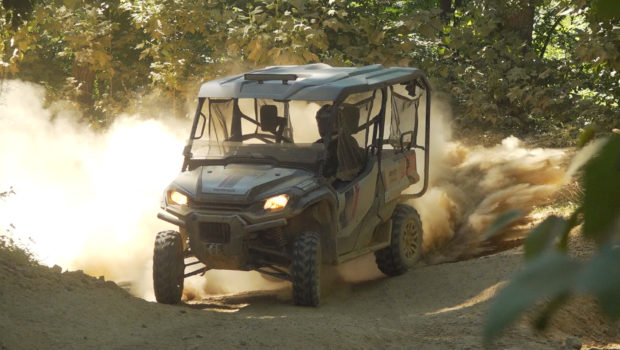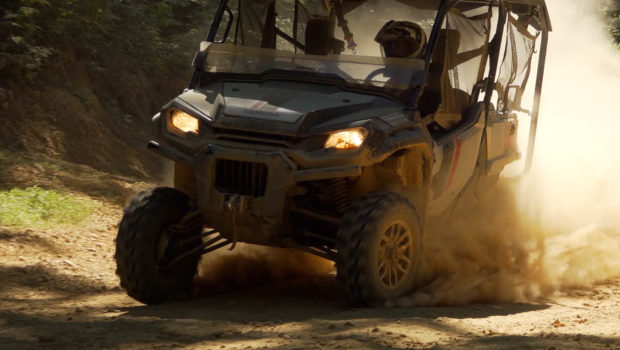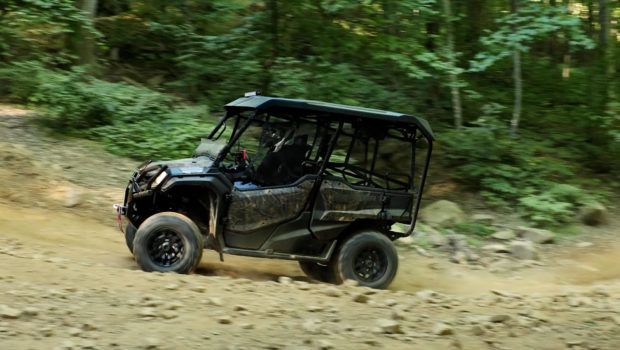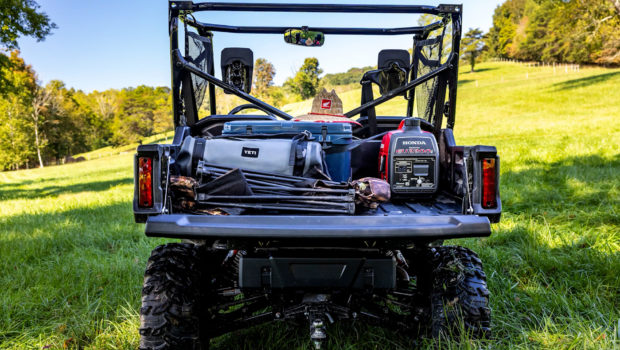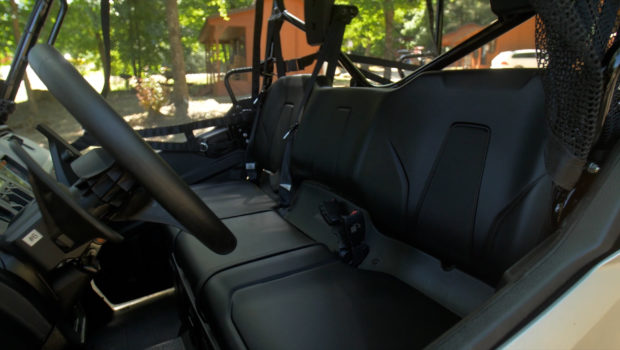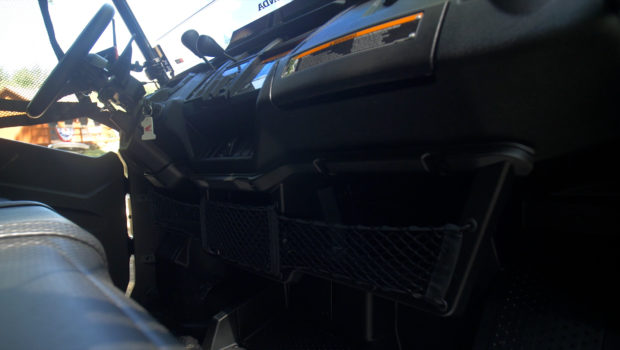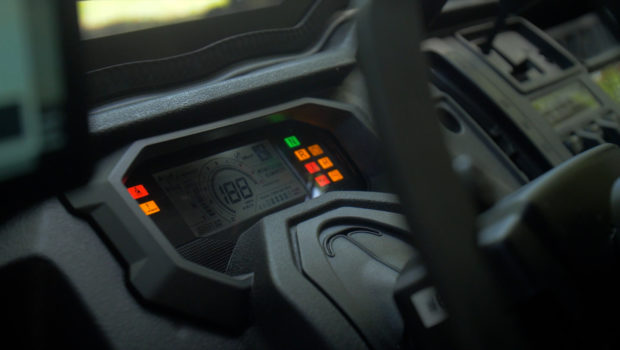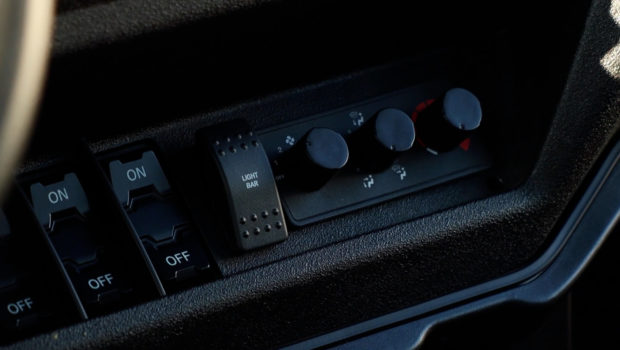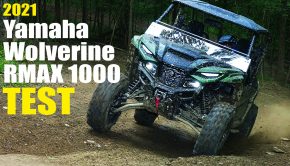Published on October 4th, 2022 | by Joe
2022 Honda Pioneer 1000 Test Review
Honda’s most popular selling side-by-sides are their work and recreation focused Pioneer 1000 models which have been updated for 2022. The 3-seat Pioneer 1000 and 5-seat Pioneer 1000-5 share virtually identical dimensions. The new 2023 Honda Pioneer-6 is a significantly longer vehicle.
For 2022, Honda is expanding on the success of the Pioneer 1000 and 1000-5 by introducing two new trim packages. The Pioneer 1000 Trail is focused on enhancing the Pioneer’s sport performance capabilities with the new Pioneer 1000 Forest focused on enhancing capability and usefulness for the hunting, camping, and fishing crowd.
To experience these new, significantly-unique models along with additional mechanical updates across the Pioneer 1000 line, we headed to Pioneer Tennessee where we met up with the crew from American Honda and other members of the media for a full day of driving and exploring on the trails of Ride Royal Blue Off-Road Park. Most of our day was spent at a rather casual pace, but fortunately, we had the chance to sneak off for a while and let the Pioneers rip!
UTV on Demand’s test of the Honda Pioneer 1000 Trail and Forest editions were bought to you by…
Trim Packages
Both the 3 and 5 seat versions of the Honda Pioneer 1000 are available in four trim packages, all equipped with electric power steering. The base model 3-seat Pioneer 1000 starts at $16,699 with the Pioneer 1000-5 starting at $18,099. Comparing pricing for the 3-seat models, the $18,099 Pioneer Deluxe features 14-inch, blacked-out aluminum wheels and body panel covers on the sides of the doors and bed. The $20,099 Pioneer 1000 Forest gains a 4,500-pound Warn winch and beefy-looking oversized front bumper, black aluminum wheels, dual bed lights, front interior light, and Honda Phantom Camo color scheme. Its most significant mechanical difference is a switch from a four-wheel-drive system with a limited-slip front differential with differential lock, to Honda’s I-four-wheel-drive. More on that later.
The $20,099 Pioneer 1000 Trail also utilized Honda’s I-four-wheel-drive. Differences from the Trail include black aluminum wheels with contrast cut highlights along with a red-accented matte silver color scheme providing a sportier appearance. It trades in the Trail’s larger coverage oversize bumper and bed lights for a ROPS mounted rear view mirror and performance enhancing Fox QS-3 shocks.
Updated Engine
Honda borrowed the 999cc, liquid-cooled, parallel twin-cylinder engine from their Africa Twin motorcycle to power the Pioneer 1000, before they used it to power their Talon sport side-by-sides. It features Honda’s proven four-valve unicam head design. Bore, stroke, and a 10:1 compression ratio are identical to the Talon’s engine. Electronic fuel injection feeds the gas via two 44mm throttle bodies. Fuel capacity is at the lower end of the class at 7.9 gallons, 3.6 gallons less than the in-class fuel capacity leader, the Polaris Ranger XP 1000.
Power was pumped up 8% through updated valve timing and throttle body settings. The increase in power allowed for a 25% increase in towing capacity and improved acceleration.
Gear ratios were updated to match the increased power output said to improve shifting smoothness. The dual clutch transmission features a six-speed gearbox with high and low forward ranges plus reverse.
Paddle shifters allow you to shift manually with no need to lift off the gas pedal or operate a clutch. The transmission automatically downshifts at low speeds. There’s also two automatic shift modes including standard and sport. Standard is more calibrated for quieter riding and fuel economy. Sport mode holds gears longer, better taking advantage of the available horsepower for quicker acceleration.
Power is strong as you would expect from a 1000. It pulls strong and smooth from idle through the midrange as you’d want from a hard working trail capable machine. It felt as though there was plenty of grunt to get a load moving or conquer most any incline you’d dare point the Pioneer up. The engine builds RPMs fast enough throughout the rev range to easily perform some spirited powerslides.
Without towing a load, steep hills and heavy sand to test the automatic shifting’s capability to hold gears without unwanted upshifts, we were impressed with both the standard and sport shift settings performance, which we switched between for most of the day. Although, if we wanted to run in auto shifting all of the time, the gearbox isn’t quite as efficient as a CVT. However, we are fans of shifting manually with the paddle shifters. It’s fun for more spirited driving, and we like the idea of being able to pick a gear for continued low-speed work duties. Another benefit is the natural engine braking feel only a gearbox provides, with less braking at higher gears and more in lower gears.
Turf mode allows the rear differential to be unlocked to protect sensitive turf from damage. Along with two-wheel drive, the Trail and Forest models trade in a lockable, limited slip front differential for Honda’s I-four-wheel-drive. The computer controlled system senses which front wheel is slipping, applies brake to that wheel, then multiplies the torque sent to the other front wheel that’s getting traction.
We’re happy to see turf mode on the Pioneer. Two-wheel-drive worked well for times we wanted to get a little sideways, although we kept I-four-wheel-drive engaged most of the time and it seemed to work flawlessly throughout the day. To be honest, I-four-wheel-drive works well and it might be a better option for beginners lacking the experience to know the rare, ideal times when a lockable front differential is needed. We’d personally prefer a standard lockable limited-slip front differential that’s found on the other Pioneer models. People buy Hondas for their reliability, and for that purpose, simple is often better.
Also found on the Trail and Forest models is Honda’s Hill start assist, a unique feature we really like for less experienced drivers. When engaged, it holds the brakes for a few seconds on hillsides until you hit the gas allowing noobs to get out of a sticky situation more confidently.
Suspension and Handling
Both the 3 and 5-seat Pioneer 1000s use essentially the same steel chassis. A rear view mirror mount was added to the cage across the line for 2022. Double-wishbone suspension is found at both ends with 10.6 inches of suspension travel up front and 10 inches of travel out back.
The Forest Edition uses gas charged shocks with five-way preload adjustment up front and self-leveling shocks used out back, designed to level the ride under load. The Trail Edition uses Fox QS3 shocks. Nitrogen reservoirs help keep the shocks oil running cool for consistent damping. Threaded spring preload adjustment and three-position compression damping is found at both ends.
Power steering is found across the Pioneer 1000 line with recalibrated steering for 2022 to improve self-alignment.
Measurements of the 3 and 5-seat models are nearly identical. The 3-seat Pioneer 1000 measures in at 63 inches wide with an 80.2 inch wheelbase, an overall height of 76.1 inches and an overall length of 120.4 inches.
The Pioneer rolls on 27×9-14 inch front and 27×11-14 inch rear Dirt Master Tires. The 3-seat models measure in at 12.8 inches of ground clearance with ½ inch less for the Pioneer 1000-5. Overall dimensions are pretty well in line with the other 3-seat competition from Polaris and Can-Am.
Driving the Forest edition in the morning and the Trail edition in the afternoon, it’s obvious that the suspension is designed to hold up to the Pioneer’s substantial payload and towing capacities. This results in a slightly rougher ride with only two adults on-board totaling around 360 pounds.
The ride was more compliant at lower speeds where the springs were doing more of the work. As speeds and bump sizes increased and more of the work was transferred to the shocks valving, the ride felt notably firmer than the Pioneer’s competitors that we’ve tested. The Forest Edition’s front shocks were set in their middle preload setting of 5, which we would have softened up given the chance. The rear self-leveling ride can’t be altered.
Hopping in the Trail edition in the afternoon, we immediately switched the Fox QS-3 shocks into their softest damping setting. This made the ride a little more forgiving, most notably in those mid-size bumps where the Pioneer needed it most. Given the opportunity to tune suspension further, we would have taken the spring preload all the way out. Going out for a high-speed test session with the Trail Edition after the group ride, we were finally able to push as hard as we wanted. At faster speeds, the ride somewhat improved as we were better able to skim our way over bumps. Bottoming resistance on bigger hits and g-outs is quite good.
Our friends at Planetsidebyside.com tell us they help their customers smooth out their Pioneer’s ride a bit and add more ground clearance by setting them up with taller 30-inch tires and front A-Arms that allow the larger tires to clear the bodywork.
We’d definitely opt for the Trail Edition knowing that the shocks could be custom tuned by an aftermarket shock tuner, something we’d pursue if we were building a full-time trail machine.
The Pioneer’s stability is very good in turns and on sidehills. High-speed stability was also pretty good for a work focused machine. Steering accuracy is also very good, doing well at straightening itself out exiting turns. The power steering feels light and well calibrated for working or the typical speeds the Pioneer will be used at. It does well at filtering out unwanted bump feedback through the steering.
Brakes
Hydraulic disc brakes with 210mm rotors are found at all four corners. Braking power and feel are both quite good. Braking feel at the pedal is excellent.
Work Capability
Both the Pioneer 1000 and 1000-5 have full-size, hydraulically assisted dumping cargo beds. Dimensions are 36x55x11 inches on the 3-seat model and 38x47x11 inches on the Pioneer-5. The biggest difference being in the flip-up jump seats in the 1000-5’s dump bed that increase the vehicle’s passenger capacity from 3 to 5. Having 5-seat capacity, a dumping cargo bed and considerably smaller dimensions than the Pioneer 1000-6 and other six-seaters will certainly be attractive to some buyers.
Two-inch hitch receivers are standard and both share 1000-pound cargo bed capacities and 2,500-pound towing capacities with the other top competitors. Again, a gearbox certainly has some advantages over a drive belt for hardcore work duties.
Interior and other details
All of the Pioneer’s use half doors, opening with interior door handles. The door nets have been redesigned. Unfortunately, a roof is not standard on any trim package. The front seat seats three with relatively upright seating and minimum bolstering as is typical on utility focused side-by-sides. This makes getting in and out repeatedly a little easier. There’s under seat storage available up front; however, the driver’s seat is not adjustable. Fortunately, there is tilt steering.
There’s a rubber sealed glove box, small center dash tray with larger trays under the dash for stowing items. Nets come standard, which helps hold items in place on the lower trays. Power outlets are found both up front and in the bed. The dash is prewired with cutouts allowing for easy accessory switch installation.
The Pioneer 1000-5 models we’re testing have two flip-up jump seats in the bed, accessible through rear bedside doors. The rear seats are ideal for young passengers or taking a couple extra adults for short runs, but the seats are too close to the floor making them uncomfortable for long rides.
Up front, seating comfort is pretty similar to the other machines in the class. However, the day ride’s super slow pace had heat noticeably building up in the cabin. You could really feel the heat from steam under the seats on creek crossings. We’d like more heat shielding for the cabin. Overall, though, the interior is pretty well appointed for getting work done.
Conclusion
Our test at Ride Royal Blue made the Pioneer feel a little out of place. Arriving back at camp, we were greeted by a Honda Talon X sport machine sitting in the pits that looked like the perfect machine for trails we’d ridden throughout the day. For a recreational trail machine, the Pioneer’s ride needs to be softened up.
Based on our experience, we believe the Pioneer 1000 would be right at home on a ranch, farm, jobsite, or used for hunting. If you have hard work to do, the Pioneer may be the right machine for you.

